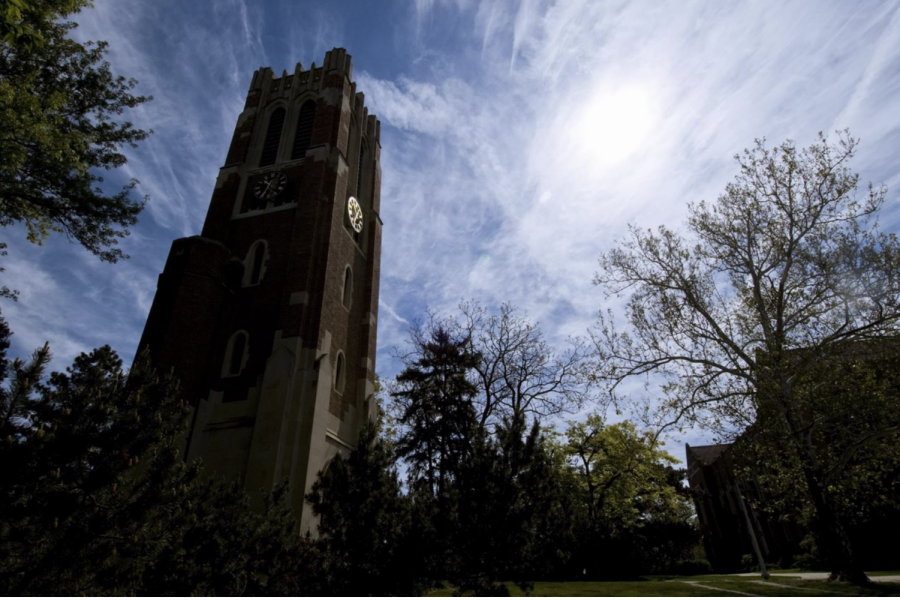Today’s weather forecast is predicting cloudy with snow showers developing during the afternoon with a high of 34 degrees and a low of 19 degrees.
MSU says farewell to ‘The Ducks’ campaign
For over 15 years, a clan of cartoon ducks have been a whimsical yet impactful part of Michigan State University’s campus culture.
“The Ducks” are colorful, creative symbols of health promotion — part of a social norms campaign coordinated by MSU’s Alcohol and Other Drug (AOD) program. They can be seen across campus on posters and flyers to promote a better understanding of student alcohol use.
MSU hosted a special event Monday, named “Farewell To The Flock,” celebrating the end of its long-running Ducks campaign. A massive line of students queued at the MSU Union, eager to grab the final pieces of beloved duck-themed memorabilia, which included limited-edition T-shirts and stickers.
The event, organized by University Health and Wellbeing (UHW), featured an evening of duck-themed activities that captured the spirit of the 15-year campaign. Students participated in trivia about the campaign’s history, decorated rubber ducks and reflected on the impact of the beloved initiative.
After 15 years, The Ducks are taking their final bow. The event Monday marked the start of a new chapter: as part of its commitment to meeting the evolving needs of students, UHW will transition to a new campaign, titled “We Polled and …”
The new initiative reflects a modern approach to health promotion, using student insight and feedback to better align with their values and priorities. The goal? To ensure the messaging remains relevant and resonates in today’s fast-paced, digitally-connected campus environment.
The campaign, originally created by MSU advertising students, used ducks as symbols to promote safe behaviors, particularly around alcohol consumption. Through posters, social media and interactive events like the annual Duck Hunt, it became a memorable and effective tool for sparking conversations about health and safety.
Art and science collide: MSU welcomes second artist in FRIB residency program
MSU’s Facility for Rare Isotope Beams (FRIB) is home to millions of dollars worth of cutting-edge equipment, from high-resolution spectrographs to neutron detectors and nuclear reaction chambers.
And now, for the second year in a row, the renowned facility has added something else to its long list of features: an artist.
New resident artist Violeta López López is the second artist to participate in the MSUFCU Arts Power Up Arts Residency at the FRIB Program. The young initiative offers an innovative combination of art and science, encouraging students to explore both from new perspectives.
The project is a collaboration between several campus organizations, including the Facility for Rare Isotope Beams (FRIB), MSU Museum, STEAMpower Project, Arts MSU, and MSU’s art, science and culture collaborative.
Violeta began her work here in September and will continue it for the remainder of the 2024 fall semester.
Originally from Spain, she studied in Valencia and earned undergraduate degrees in fine arts and music and continued with a master’s in fine arts.
As an interdisciplinary artist, her current work explores intersections of seemingly unrelated fields. Using interactive exhibits and tech, she expresses her interpretation of linguistics and physics and their parallels through art.
In this portion of the program, the artist has the opportunity to be a student as well, spending time embedded and engaged with scientists and researchers at MSU’s FRIB. For now, she is gathering insights and materials from scientists while studying subjects like physics to deepen her understanding and integrate these concepts into her work.
The research phase also involves Violeta working directly with Professor Artemis Spyrou, who oversees FRIB outreach. Artemis’ work is in experimental nuclear astrophysics, designing and conducting experiments to study nuclear reactions and the properties of stars with the goal of understanding their functions and reproducing those elements.
Next, Violeta will move to the working phase of her residency. She will then create art in her vision from the knowledge she has gained while collaborating with FRIB researchers.
Her work and interactive exhibition will go on display in the MSU Museum’s temporary gallery this coming fall 2025.
Based on original reporting by Satvik Shubham and Shealyn Paulis.

















